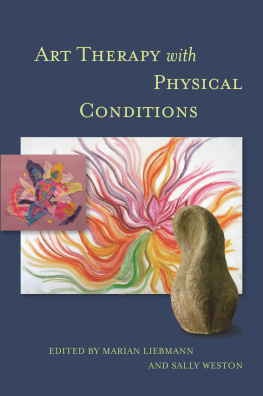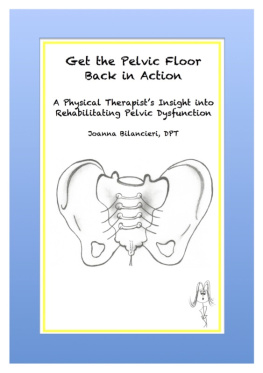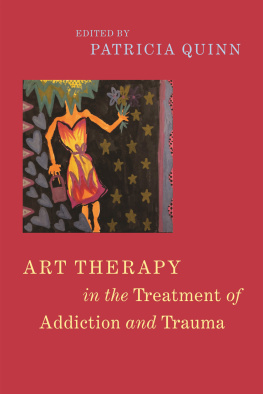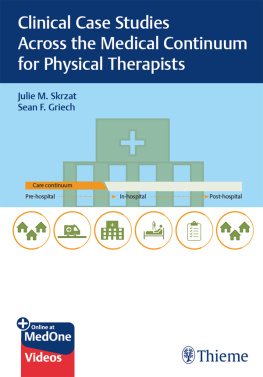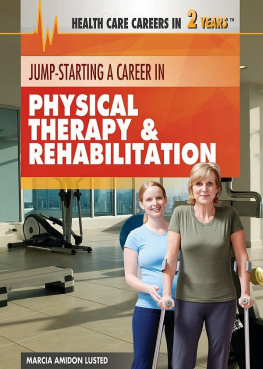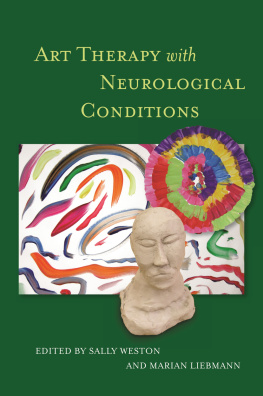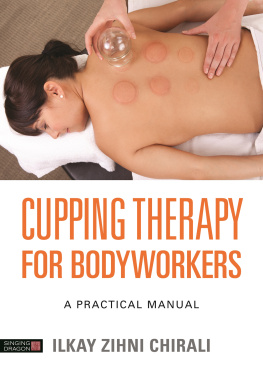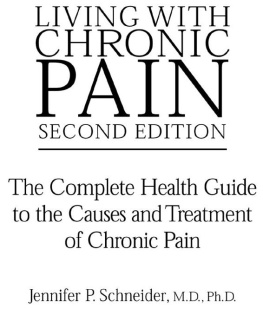
This book is not only extremely timely; it is also very well written, edited, and full of vivid illustrations. I am truly delighted to be able to recommend it to art therapists on both sides of the pond. Interest in this area is growing rapidly, as our recognition of the intimate relationship between psyche and soma is at last leading to the provision of creative avenues of expression for those living through bodily traumas over which they have little control, but with which they must cope.
Judith A. Rubin, PhD, Licensed Psychologist, Psychoanalyst, Art Therapist, Author, Faculty Member of Psychiatry Department of the University of Pittsburgh and the Pittsburgh Psychoanalytic Center
This book opens the door on the inspiring lives of people with physical conditions in the success driven able-bodied world. It charts powerful and profound stories of peoples pain and resilience and of how art therapy again and again facilitates a process of recovery and reconciliation for those who may be facing the challenge of increasing vulnerability, loss of independence or death. An important and enlightening book.
Cathy Ward, Art Therapist and EMDR Practitioner with children and families
A very broad ranging discussion of the subject and, as promised in the preface, going far beyond the known areas that art therapy is usually associated with.
Hilary Curwen, Art Psychotherapist
In The Illness Narratives the thoughtful American medic Arthur Kleinman wrote: Acting like a sponge illness soaks up personal and social significance from the world of the sick person (1988:31). It is often in response to such experiences that the work of art therapy can be understood. This book is valuable in the way it gives voice to people with physical conditions who make art and meet with art therapists. Many different approaches to art therapy are described and offered as a way of contributing to the recovery of a persons energy and sense of significance.
Chris Wood, author of Navigating Art Therapy , Team Leader of Art Therapy Courses Northern Programme UK and Honorary Research Fellow with the University of Sheffield
Art Therapy with Physical Conditions
companion volume
Art Therapy with Neurological Conditions
Edited by Sally Weston and Marian Liebmann
ISBN 978 1 84905 348 8
eISBN 978 0 85700 912 8
of related interest
Assessment and Outcomes in the Arts Therapies
A Person-Centred Approach
Edited by Caroline Miller
ISBN 978 1 84905 414 0
eISBN 978 0 85700 788 9
End of Life Care
A Guide for Therapists, Artists and Arts Therapists
Nigel Hartley
ISBN 978 1 84905 133 0
eISBN 978 0 85700 336 2
Art Therapy and Creative Coping Techniques for Older Adults
Susan I. Buchalter
ISBN 978 84905 830 8
eISBN 978 0 85700 309 6
Promoting Psychological Well-Being in Children with Acute and Chronic Illness
Melinda Edwards and Penny Titman
ISBN 978 1 84310 967 9
eISBN 978 0 85700 395 9
Art Therapy with Physical Conditions
Edited by Marian Liebmann and Sally Weston

Jessica Kingsley Publishers
London and Philadelphia
Excerpt on page 247 from The Little Prince by Antoine de Saint-Exupery. Copyright 1943 by Houghton Mifflin Harcourt Publishing Company. Copyright renewed 1971 by Consuelo de Saint-Exupery, English translation copyright 2000 by Richard Howard. Reprinted by permission of Houghton Mifflin Harcourt Publishing Company. All rights reserved.
First published in 2015
by Jessica Kingsley Publishers
73 Collier Street
London N1 9BE, UK
and
400 Market Street, Suite 400
Philadelphia, PA 19106, USA
www.jkp.com
Copyright Jessica Kingsley Publishers 2015
Foreword copyright Trevor Thompson 2015
All rights reserved. No part of this publication may be reproduced in any material form (including photocopying or storing it in any medium by electronic means and whether or not transiently or incidentally to some other use of this publication) without the written permission of the copyright owner except in accordance with the provisions of the Copyright, Designs and Patents Act 1988 or under the terms of a licence issued by the Copyright Licensing Agency Ltd, Saffron House, 610 Kirby Street, London EC1N 8TS. Applications for the copyright owners written permission to reproduce any part of this publication should be addressed to the publisher.
Warning: The doing of an unauthorised act in relation to a copyright work may result in both a civil claim for damages and criminal prosecution.
Library of Congress Cataloging in Publication Data
A CIP catalog record for this book is available from the Library of Congress
British Library Cataloguing in Publication Data
A CIP catalogue record for this book is available from the British Library
ISBN 978 1 84905 349 5
eISBN 978 0 85700 911 1
Contents
List of Figures
Foreword
Art and Medicine are closer bedfellows than we sometimes imagine. In our work with medical students at the University of Bristol we explore two aspects. Firstly, the Art of Medicine in the clinical sense. Even doctors closely wedded to the scientific method acknowledge that the actual practice of clinical medicine is both Art and Science . From my GP consulting room in inner-city Bristol, I am engaged in the time-honoured game of winning trust, dispensing hope and calming the anxious mind.
Alongside this clinical art we have what might be termed the Arts on Medicine, that vast array of artistic work that deals with medicine and medical themes. In lectures I illustrate this second aspect with a slide of The Doctor, the iconic oil painting by Sir Luke Fildes, which hangs in Tate Britain. Whole theses have been written on this work and what it says about doctoring, social medicine and the sensibilities of the Victorian public. The Bristol Medical School has also pursued a campaign to engage students in creative work on medical themes, now curated at www.outofourheads.net.
Reading Art Therapy with Physical Conditions reminds me of a third vital element Art as Medicine. Doctors in the UK, if they have encountered art therapy at all, will, I guess, have met it in mental health settings. This edited collection has opened my thinking to a whole new dimension using art as a therapeutic agent with very physical diseases such as cancer. Why might we want a therapy of the physical? Well, obviously, serious illness leaves a lot of emotion in its wake. Loss of function, loss of dreams and even loss of actual bodily parts. And treatments can be both life-saving and bloody harsh to endure. Sometimes what seems physical can be the boiling up of problems which feel more emotional in hue (see for instance Isabels story on page 41). All these troubles can yield to artistic expression.
Patients so often present symptoms that are medically baffling, lead to no satisfying diagnoses and which seem purposed only to torment both patient and doctor. From my experience, such symptoms, when properly heard, are themselves a type of communication, a language of the body. The arts provide a fabulous means to hear and draw meaning from this inscrutable tongue as evidenced in many of the case histories presented in this volume. The notion of symptoms as something useful, wise even, is pretty revolutionary in a culture where they are generally pursued to extinction.
I am especially glad to see artistic approaches used in the care of children who speak so eloquently through their hands, and often so guardedly with their tongues. I keep a big sketch pad in my consulting room and offer it up to children to sketch their families or their symptoms and I include the output with referrals to bemused hospital colleagues. It was inspiring to see work with children taken to real depth, for example with Andrew and his Dragon (page 230). Any situation where medicine and words have failed, image and metaphor can come to our mutual rescue.
Next page
